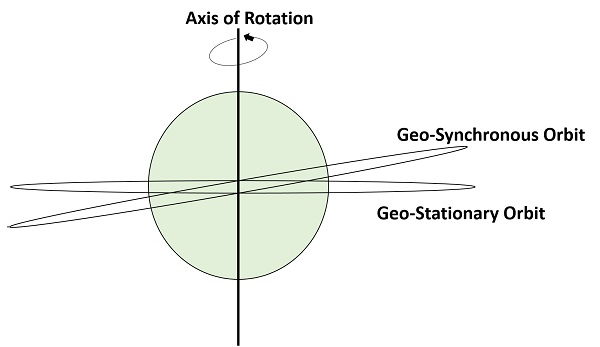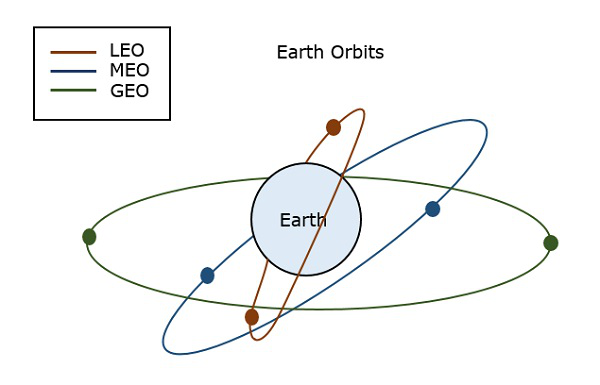Satellite Communication
Principle of satellite communication
A satellite is a body that moves around another body in a mathematically predictable path called an Orbit. A communication satellite is nothing but a microwave repeater station in space that is helpful in telecommunications, radio, and television along with internet applications.
A repeater is a circuit which increases the strength of the signal it receives and retransmits it. But here this repeater works as a transponder, which changes the frequency band of the transmitted signal, from the received one.
The frequency with which the signal is sent into the space is called Uplink frequency, while the frequency with which it is sent by the transponder is Downlink frequency.
The following figure illustrates this concept clearly.

Now, let us have a look at the advantages, disadvantages and applications of satellite communications.
Satelite communication − Advantages
There are many Advantages of satellite communications such as −
* Flexibility
* Ease in installing new circuits
* Distances are easily covered and cost doesn’t matter
* Broadcasting possibilities
* Each and every corner of earth is. covered
* User can control the network
Satellite communication- Disadvantage
Satellite communication has the following drawbacks −
1) The initial costs such as segment and launch costs are too high.
2) Congestion of frequencies
3) Interference and propagation
Satellite Communication − Application
Satellite communication finds its applications in the following areas −
1) In Radio broadcasting.
2) In TV broadcasting such as DTH.
3) In Internet applications such as providing Internet connection for data transfer, GPS applications, Internet. surfing, etc.
4) For voice communications.
5) For research and development sector, in many areas.
6) In military applications and navigations.
Earth orbit :-
A satellite when launched into space, needs to be placed in a certain orbit to provide a particular way for its revolution, so as to maintain accessibility and serve its purpose whether scientific, military, or commercial. Such orbits which are assigned to satellites, with respect to earth are called as Earth Orbits. The satellites in these orbits are Earth Orbit Satellites.
The important kinds of Earth Orbits are −
* Geo Synchronous Earth Orbit
* Medium Earth Orbit
* Low Earth Orbit
Geosynchronous Earth Orbit Satellites
A Geo-Synchronous Earth Orbit (GEO) satellite is one which is placed at an altitude of 22,300 miles above the Earth. This orbit is synchronized with a side real day (i.e., 23hours 56minutes). This orbit can have inclination and eccentricity. It may not be circular. This orbit can be tilted at the poles of the earth. But it appears stationary when observed from the Earth.
The same geo-synchronous orbit, if it is circular and in the plane of equator, it is called as geo-stationary orbit. These satellites are placed at 35,900kms (same as geosynchronous) above the Earth’s Equator and they keep on rotating with respect to earth’s direction (west to east). These satellites are considered stationary with respect to earth and hence the name implies.
Geo-Stationary Earth Orbit Satellites are used for weather forecasting, satellite TV, satellite radio and other types of global communications.
The following figure shows the difference between Geo-synchronous and Geo-stationary orbits. The axis of rotation indicates the movement of Earth.

Every geo-stationary orbit is a geo-synchronous orbit. But every geo-synchronous orbit is NOT a Geo-stationary orbit.
Medium earth orbit satellite :-
Medium Earth Orbit (MEO) satellite networks will orbit at distances of about 8000 miles from the earth's surface. Signals transmitted from a MEO satellite travel a shorter distance. This translates to improved signal strength at the receiving end. This shows that smaller, more lightweight receiving terminals can be used at the receiving end.
Since the signal is travelling a shorter distance to and from the satellite, there is less transmission delay. Transmission delay can be defined as the time it takes for a signal to travel up to a satellite and back down to a receiving station.
For real-time communications, the shorter the transmission delay, the better will be the communication system. As an example, if a GEO satellite requires 0.25 seconds for a round trip, then MEO satellite requires less than 0.1 seconds to complete the same trip. MEOs NJ in the frequency range of 2 Ghz and above.
Low earth orbit satelite :-
The Low Earth Orbit (LEO) satellites are mainly classified into three categories namely, little LEOs, big LEOs, and Mega-LEOs. LEOs will orbit at a distance of 500 to 1000 miles above the earth's surface.
This relatively short distance reduces transmission delay to only 0.05 seconds. This further reduces the need for sensitive and bulky receiving equipment. Little LEOs will operate in the 800 MHz (0.8 GHz) range. Big LEOs will operate in the 2 GHz or above range, and Mega-LEOs operates in the 20-30 GHz range.
The higher frequencies associated with Mega-LEOs translates into more information carrying capacity and yields to the capability of real-time, low delay video transmission scheme.
The following figure depicts the paths of LEO, MEO, and GEO.


Comments
Post a Comment